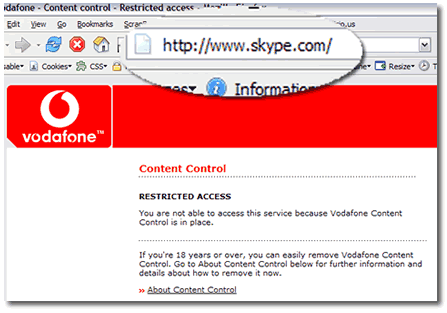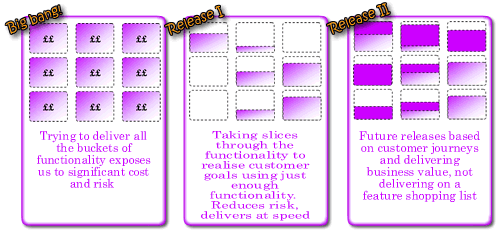Gripe about your N80
Here’s a user survey where you can moan to Nokia about how bad your N80 is (or any other N series phone).
Here’s a user survey where you can moan to Nokia about how bad your N80 is (or any other N series phone).
There once was a time that you could go to any office in the world and be able to charge your Nokia phone. Every Nokia phone used the same charger. A small and insignificant thing, yet this small detail in the technical implementation was undoubtedly important in maintaining brand loyalty and the dominance of Nokia in the market place. Nokia built informal communities in workplaces that no other brand did. Communities that shared their chargers. I’ve not witnessed that with other brands.
Then something happened at Nokia. They changed the charger. The plug is now smaller. I presume this can only be down to the ever decreasing size of their phones. But my new Nokia N80 is bigger than my old Nokia that used the old charger. Bottom line? There are half a dozen old style chargers lying around in the office. There are no new ones around. I leave mine at home / it is broken, and combined with the risibly short battery life of the N80, I am stuffed. This will impact my purchasing decision when I change phones. I’ve been loyal to Nokia since I got my first mobile almost ten years ago. No more.
(As a postscript, I recently found myself with three other unlucky souls who owned a Nokia N80. Not one of us had a good thing to say about it. If you are in the market for a new phone, steer clear of the N80. Buy one at your peril!)
I recently picked up an old BT phone at a car boot sale. Using it made me realise how using the phone has radically changed since my youth.
Then: In those days you remembered all your phone numbers- the frequently used ones at least. Others would be in a notepad that was close to the phone.
Now: Phones have memories, the notepad is in the phone. And frequently used numbers can be set as speed dial. (It’s an interesting question whether the move to from analogue to digital phones has had an impact on memory…)
Then: To make a phone call with x digits would take y seconds. Oooooh how slow and painful! The pleasure of the retro experience using the old phone soon turned to frustration. How long to dial a number? And if the number was engaged there was no such thing as a rapid redial.
Now: the fingers fly accross the keypad. Engaged? wait a few minutes and press redial.
Two words articulate the new experience; speed and convenience. The old BT phone sits in the lounge. It sounds cool when it rings. I may pick it up. But use it to dial numbers? I’ll stick with the modern experience of speed and convenience.

Bad experience #1. Got a mail from Skype telling me that because I’ve not used their service for a while they are going to “expire” my credit.
Skype Credit expires 180 days after your last purchase or SkypeOut call. If you’re not using your balance we need to expire the credit sooner or later to comply with normal business accounting rules
Eh? I’ve topped up my account with money, what rules are these that confiscate it for not having made a skype call in a while?
Bad experience #2
So I want to visit Skype and see exactly how much I am going to loose, and take a good look at the rules. I’m using a vodaphone 3G card. I link to a skype URL and…

Eh? Skype is “restricted content”.
On what grounds is that I wonder.
Imagine.
I go into a store and a salesperson helpfully shows me the product, but I’m not yet ready to commit. She offers me a great deal, I’m tempted, but I want to check it out on the web. She says “great!” scans the products and prints me of a personal card with a short unique identifier and a unique website URL. I search the competitors, the salesperson was right, she was offering me a really good deal. So I got to their online shop and enter the URL and there is the tailored deal that the salesperson told me about. It has even got her name on it (so I know he’s going to get some credit for the sale). I get through to the checkout screen. I enter my personal details and I’m just about to buy, but I’ve got a question about the terms and conditions so I take a pause in filling out the form. There’s a number on the website and I get through to the call centre. I don’t have broadband so I loose my connection. The voice at the end of the phone knows who I am and where I am up to. I’m ready to commit… but she apologises, she doesn’t have any in stock. I’ll have to wait seven days. But I could pick it up from the store tomorrow if I want (or even a store close to where I work) or I can get the store to deliver if that would be more convenient. I’m delighted. The next day I go to the store and it is waiting to me. The sales person smiles. She didn’t take my money, but she ultimately made the sale and she’ll be rewarded for it.
Fantasy? It shouldn’t be. Thinking in terms of the customer experience and the customer journey is only the first baby step. The giant leap is to get IT bought into it and implement a solution that is not going to cost the earth and take years to (not) deliver.
And that’s where ThoughtWorks comes in. We thrive on getting everybody together and using creative, collaborative and highly visual techniques we quickly get everybody to consensus on the vision we want to move forward on. Because we are an IT company, we understand the opportunities and constraints with technology. But most importantly because we use lean and agile techniques to delivering technical solutions we are responsive to change, flexible with emerging requirements and can focus on getting things done – the baby steps – whilst working towards the giant leap that will win lifetime value for customers. Hmmmm. That’s beginning to sound like marketing blurb.
Let’s imagine a mobile phone provider that that has an on-line presence as well as a high street retail network. Their current website was built several years back on legacy technology; it is slow and has a conversion rate lower than industry norms. Along with having poor usability, the current shopping cart functionality does not support the concurrent usage figures that are hitting the site. The business takes the output from their web metrics and throw these at IT and demand improvements. And a new IT project is born. Rebuild the existing site on a new platform. They get a design agency to handle the look and feel. The functional requirements are built upon the existing functionality and chunked into functional silos:
A typical project process. That is flawed. It is starting with a functional premise. An alternative is to think in terms of the customer and customer journeys.
We can start by asking who the customers are. Almost certainly the marketing department has a customer segmentation model – this is a good place to start. That may give us basic attitudinal and behavioural details on customers, but we need richer data. How do customers shop for phones? So we go and spend time in the stores and observe how people buy them. It soon becomes clear that the choose phone – choose tariff buy model is a journey that is only taken by a certain number of customers. Other customers come into the store with intentions – they don’t know what phone or tariff they want, but they know what they want a mobile phone for. Other customers come into the store asking lots of questions, they are doing research; they leave the store with the sales guy’s number, and costs for a couple of phones and tariffs. We look at the competition and see how they sell phones. We look at Amazon and eBay and expedia and see how other retailers sell products and experiences on the web. We synthesise our research and suddenly we have a whole bunch of new requirements. Gasp! Scope creep. Indeed if we list them out into functional silos again:
The business is excited and IT is despondent. When the business announce the date all this must go live by, the letters of resignation land on the IT directors desk and they start looking for contractors. It does have to be this way. You can have your cake and eat it.
Rather than thinking about vertical functional silos, we should think about horizontal slices through the functionality. Slices that support customer journeys. We can start with simple journeys to start and build complexity as we prove our process and new platform, mitigating technical risk as we progress.

The first release probably needs to demonstrate the new platform works: we can deliver on time; that a new shopping cart interfaces with our legacy warehouse order management system; etc. What’s the bare minimum we can do that does this and delivers business value. How about a microsite that sells a single product. Customers are directed to the microsite via a URL published on a flyer handed out in the stores.
As a customer who has picked up a special offer N80 deal flyer, I want to buy a Nokia N80 on a pay as you go contract
Our acceptance criteria:
Given I enter my personal details and credit card details When my credit card details are validated Then send order to warehouse to dispatch phone and activate contract.
We can decompose this requirement into discrete requirements, “stories” of sufficiently small size and estimate them. We’ll soon get a project velocity and because it is only a small release expectations, risks and dependencies will be easy to manage. We’ve not had to wait for months to get something out, everybody is happy.
We identify that a profitable segment of the market are the aspirationally clueless. People who want a mobile phone, realise they are a minority who don’t have one but are too afraid to admit they have no idea what they want. So we build a new customer journey.
As an aspirationally clueless I want say what I do and how I live my life and have a suitable phone selected for me.
OK, not the finest story, but you get the point. This story might take elements of the phone selection and tariff selection functional silos, but just enough to realise the required functionality. Because we are building around customer journeys, just enough to realise customer intentions that support those journeys we build only what is required. We are not building by feature list. We don’t over promise and under-deliver. We are building trust with all stakeholders. Surely this is the better way to build software, thinking about customer intentions and incrementally delivering to support more complex customer goals. Sadly, people all too often get fixated by feature lists. Because that is what they are used to. Because that is how products are sold. But isn’t there a marketing 2.0 where we sell experiences and go beyond the product. Isn’t that what Virgin does? But I’m probably off on a tangent.